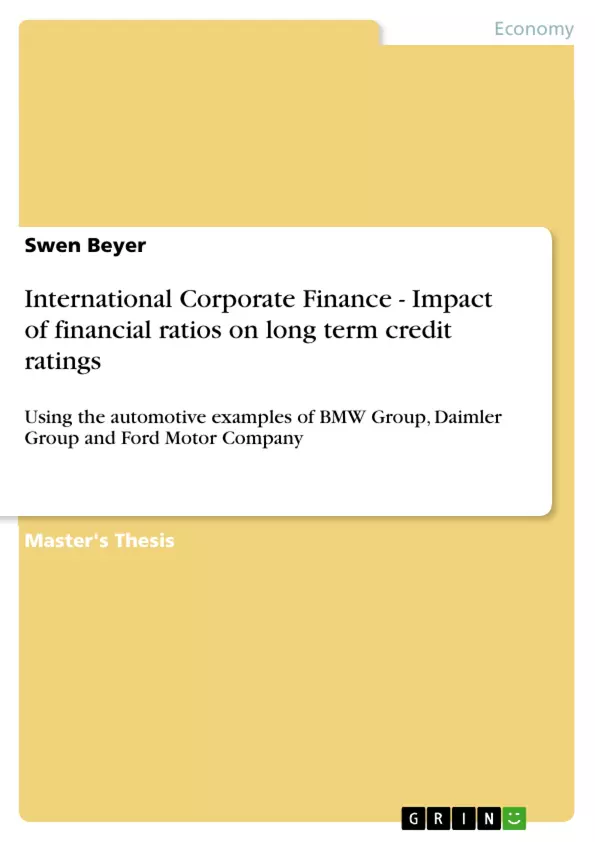The global financial and economic crises resulted for many corporations in a downgraded credit rating within the last 2 to 3 years. Even a large percentage of them defaulted on their credit obligations due to inherent operational factors. The importance of credit ratings will play an even more central role under the currently discussed New Basel Capital Accord (Basel III) (Standard & Poor´s 2010; Basel III For Global Banks).
The purpose of this research is to explore the relationship between long term credit ratings and selected financial ratios that can be derived by public information. Such information can be very valuable for companies in order to have a slight control over their credit rating obtained by rating agencies as well as in negotiations with banks and other outside creditors.
The research design is based on three automotive manufacturers and involves their credit rating over the last decade. The data for the financial ratios was collected from respective financial statements.
The study is based on a correlation and multiple regression analysis using the MINITAB (Minitab Data Analysis Software, Pennsylvania USA) software as a statistical platform. A step wise approach determined the regression equation with the highest significance. The equations were used to detect those variables that have the strongest impact on the credit rating.
The results for automotive companies with a solid statistical data set are surprisingly high in significance with an adjusted coefficient of determination of over 90%. Overall it is not feasible to mention which one of the seventeen financial ratios explains the variation in credit rating most reliable, because such a statement depends always on the individual company. For example to explain the changes in the rating for the Ford Motor Company, the following six ratios turned out to be the most significant ones: total equity to total assets; sales to fixed assets; sales to inventory; net income to total equity; total equity to long term liabilities and EBIT to sales.
Each regression equation consisted mostly of different financial ratios. Apart from the fact that financial information is only one aspect of the credit rating determination process, the attained results are valid and valuable insights for all external and internal rating analysts.
The global financial and economic crises resulted for many corporations in a downgraded credit rating within the last 2 to 3 years. [...]
Inhaltsverzeichnis (Table of Contents)
- SUMMARY
- ACKNOWLEDGEMENTS
- CHAPTER 1: INTRODUCTION
- 1.1 The Importance of Credit Ratings
- 1.2 The Significance of this Research
- 1.3 Scope and Structure of this Thesis
- CHAPTER 2: LITERATURE REVIEW
- 2.1 Rating Agencies and their Ratings
- 2.2 Determinants of Credit Ratings
- 2.3 Financial Ratios and their Impact on Credit Ratings
- 2.4 Limitations and Challenges of Applying Financial Ratios to Credit Ratings
- CHAPTER 3: RESEARCH METHODOLOGY
- 3.1 Data Collection
- 3.2 Statistical Analysis
- 3.3 Data Limitations
- CHAPTER 4: ANALYSIS AND RESULTS
- 4.1 BMW Group
- 4.2 Daimler Group
- 4.3 Ford Motor Company
- CHAPTER 5: DISCUSSION
- 5.1 Summary of Results
- 5.2 Implications and Recommendations
- 5.3 Limitations and Future Research
- CONCLUSION
Zielsetzung und Themenschwerpunkte (Objectives and Key Themes)
This master thesis investigates the relationship between long-term credit ratings and specific financial ratios derived from publicly available information. It aims to determine how these financial ratios can influence credit ratings, providing valuable insight for companies and investors. The research uses three automotive manufacturers (BMW Group, Daimler Group, and Ford Motor Company) as case studies, analyzing their credit ratings over a decade.
- The impact of financial ratios on long-term credit ratings
- The significance of credit ratings in the context of financial markets
- The application of statistical analysis to examine the relationship between financial ratios and credit ratings
- The implications of the research findings for companies, investors, and rating agencies
- The limitations of using financial ratios as a sole determinant of credit ratings
Zusammenfassung der Kapitel (Chapter Summaries)
- CHAPTER 1: INTRODUCTION: This chapter introduces the research topic, highlighting the importance of credit ratings and the significance of understanding their relationship with financial ratios. It also outlines the scope and structure of the thesis.
- CHAPTER 2: LITERATURE REVIEW: This chapter provides a comprehensive overview of existing literature on credit ratings, including the roles of rating agencies, determinants of credit ratings, and the use of financial ratios in credit rating analysis. It also discusses the challenges associated with applying financial ratios to credit ratings.
- CHAPTER 3: RESEARCH METHODOLOGY: This chapter details the research methodology, including data collection procedures, statistical analysis techniques, and potential data limitations. It outlines the specific approach used in the thesis.
- CHAPTER 4: ANALYSIS AND RESULTS: This chapter presents the analysis and results of the study, focusing on the relationship between financial ratios and credit ratings for each of the three automotive manufacturers. It includes detailed discussions of the findings for each company.
- CHAPTER 5: DISCUSSION: This chapter summarizes the main findings of the study and discusses their implications for companies, investors, and rating agencies. It also identifies limitations of the study and suggests areas for future research.
Schlüsselwörter (Keywords)
The study focuses on the relationship between long-term credit ratings and financial ratios in the context of the automotive industry. Key concepts explored include credit rating agencies, financial ratios, statistical analysis, and the impact of financial performance on creditworthiness.
- Quote paper
- Swen Beyer (Author), 2010, International Corporate Finance - Impact of financial ratios on long term credit ratings, Munich, GRIN Verlag, https://www.hausarbeiten.de/document/162227


